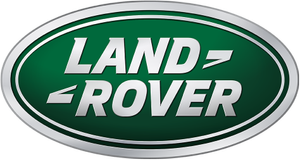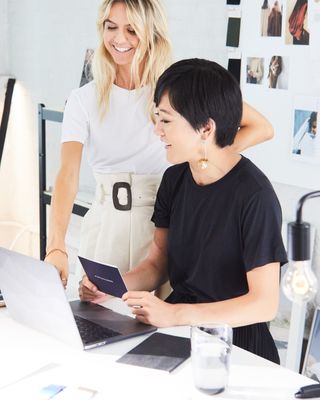
The ADAY offices in Manhattan’s Chinatown are a flurry of activity: There’s a conference call happening in one corner and a meeting at a long wooden table in another. In the showroom in the space’s center, a regular customer is trying on some of the brand’s new pieces, while co-founder Meg He’s dog, Helix, weaves through the racks of T-shirts and tanks.
The hubbub is somewhat temporary. The company, which was founded in 2015 with the philosophy of “doing more with less,” is hitting a growth phase and planning to move into a bigger space soon. That one will also have an area that’s open to the public, says co-founder Nina Faulhaber, which will give the team a direct line of communication with ADAY’s customers.
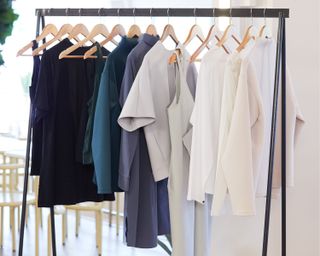
Even in the golden age of direct-to-consumer brands, ADAY has an uncommonly democratic relationship with its fans. Its most recent launch, the five-piece Carry-On Capsule, was designed with the aid of surveys emailed out to thousands of customers last spring.
“We asked them, ‘What do you want to see from us next?’ And they said, ‘a dress.’ And then we sent another survey and we asked, ‘OK, do you want to see a wrap dress or a slip dress? Do you want sleeveless or sleeves?’ They told us pretty specifically what they wanted, so the dress we ended up designing was probably the most successful dress we could have designed,” Faulhaber says.
“We asked our customers, ‘What do you want to see from us next?’”
Faulhaber and He have been “blown away” by the interest in dresses, a category they weren’t necessarily expecting to design back when the brand launched in 2015. At the time, its über-popular leggings and leather-look track pants were in line with the athleisure trend, but the pieces ADAY has debuted since give a clearer picture of the founders’ goal: to create a more functional, versatile wardrobe for everyday life.

Their embrace of crowdsourcing and A/B testing could be owed to the fact that both of their backgrounds are in tech and finance rather than fashion design; both women met as analysts at Goldman Sachs in London, where He grew up and where ADAY has its second offices, and the pair worked in venture capital before striking out on their own. It’s also a product of their interest in sustainability, something that’s been a part of the brand’s DNA since its earliest days.
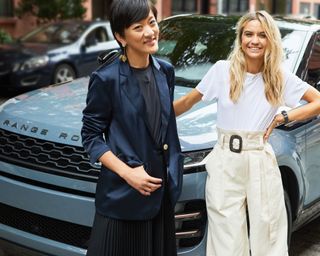
Looking at a product like the dress—now a sleeveless asymmetrical wrap style with an optional adjustable belt—He says, “If people don’t actually want it, then why are we putting it into existence? We always want to be super thoughtful about everything that we do, and we do believe that ultimately the customer is right, but also that the customer is one of us.”
That means that the customer has a (metaphorical) seat at the table when it comes to the brand’s decision-making, whether through surveys, customer service messages, returns feedback, or in-person at the showroom.
He and Faulhaber have come to recognize that building a sustainable company is about more than using eco-friendly materials or recycled packaging (although ADAY does both). It also means being financially responsible, which is part of why they’ve been more conservative about marketing spend than many of their peers, sticking to word-of-mouth and press at first and then adding a referral program to amplify their existing base.
Building a sustainable company is about more than using eco-friendly materials or recycled packaging; it also means being financially responsible.
Early on, says Faulhaber, “We raised money, but we wanted to make sure we proved the market first and proved the products. [We wanted to know we were] putting out a product that people really love as opposed to throwing money at marketing and not really knowing if people would like the product.”
Adds He, “as founders, we have so much accountability to everyone on the team, as well as our customers, that this is a company that we want to grow into a very large business because we’re doing good things for the world. And so we have to spend carefully and sustainably and not blow it.”

Now, though, the company is ready to expand, and it has numerous avenues in which to do so. With a fresh infusion of funding (the details of which are still under wraps), He and Faulhaber are recruiting for roles in marketing, finance, branding, and other areas, and looking at locations for pop-up shops in San Francisco and other cities.
With the launch of its Carry-On Capsule this spring, the brand made an addition to its site: carbon offsets, giving customers the option of paying between $2 and $8 to counterbalance their flight emissions by supporting reforestation efforts in Peru. ADAY’s customers say they’re seeking out the brands’ offerings for travel (in addition to work), and Faulhaber and He are trying to find ways to promote the most sustainable version of that as the company grows.
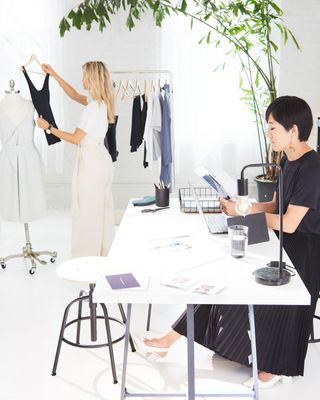
Scaling a business is, inevitably, challenging as well as exciting, and a rock-solid relationship is key for the co-founders—and it takes work. One step they’ve taken is working with a CEO coach, which He says “has been such a powerful addition to our relationship, really making the two of us much more synergistic.”
Another has been working directly with a mentor. Through a partnership with The Wing and Range Rover Evoque, He and Faulhaber were also paired up with Natalia Oberti Noguera, the founder and CEO of Pipeline Angels, “a network of women and femme angel investors focused on funding women and femme entrepreneurs.”
Oberti Noguera advised the founders on everything from scaling and balancing their culture, to hiring better and smarter, to nurturing their team, especially at this stage of the company. “This is what they don’t tell you—there are growing pains,” she said during one session. Taking ADAY’s own tagline to heart, she advised: “You need to do more with less, especially in the early days. As much as you want to strive for excellence, sometimes you just have to strive.”
“You need to do more with less, especially in the early days. As much as you want to strive for excellence, sometimes you just have to strive.”
In any kind of working relationship, but especially as co-founders, communication is everything, and He says they’ve learned over the years to keep their own egos in check in order to put the company first.
In the beginning, “I would say something that was very much about me instead of us, but not even intentionally. It’s just hard to always look at the world from both of your perspectives or from a whole company’s perspective,” He says. “Over time we got much, much better at doing that, but also at forgiving the other person if they say the wrong thing.”
Key to this understanding is a willingness to always talk it out. “Both of us investing in our relationship through conversation, through constant dialogue, really has been the number-one most important investment into the company,” Faulhaber says.
He puts it even more succinctly: “We’ve realized there’s no one else out there who has both ADAY’s and our interests more at heart than the other person.”
Worn throughout: Meg - The Frankie Shop blazer, ADAY top, Proenza Schouler skirt, Zara shoes, Nina - ADAY top, The Frankie Shop pants, ASOS shoes, Leigh Miller hoops
Stay In The Know
Marie Claire email subscribers get intel on fashion and beauty trends, hot-off-the-press celebrity news, and more. Sign up here.
-
 This Week's Best On-Sale Picks Include a Tory Burch Bag and Pretty Silver Ballet Flats
This Week's Best On-Sale Picks Include a Tory Burch Bag and Pretty Silver Ballet FlatsWarm weather is finally here—it's time to dress like it.
By Brooke Knappenberger Published
-
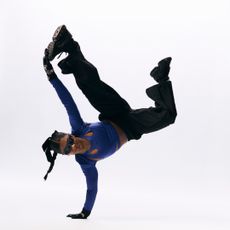 A Sporty It-Sneaker Era Is About to Begin
A Sporty It-Sneaker Era Is About to BeginNike's next Air models are designed for Olympic athletes, but they'll soon be all over street style.
By Halie LeSavage Published
-
 These Luxury Beauty Gifts Are Proven to Make Mom Feel Spoiled on Mother’s Day
These Luxury Beauty Gifts Are Proven to Make Mom Feel Spoiled on Mother’s DayThe best in makeup, haircare, and skincare for your favorite woman.
By Brooke Knappenberger Published
-
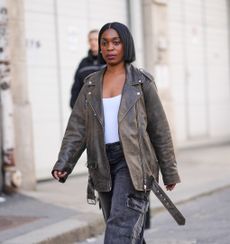 Stylists on Why Leather Jackets Are a Great Investment
Stylists on Why Leather Jackets Are a Great InvestmentFashion insiders weigh in on their favorite styles.
By Lauren Tappan Published
-
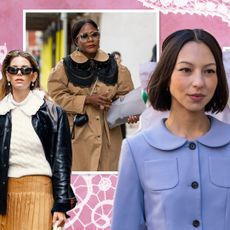 Grown-Ups Are Rediscovering the Charm of Peter Pan Collars
Grown-Ups Are Rediscovering the Charm of Peter Pan CollarsFrom bibbed button-downs to round-neck leather jackets, this year's takes feel more sophisticated than sweet.
By Emma Childs Published
-
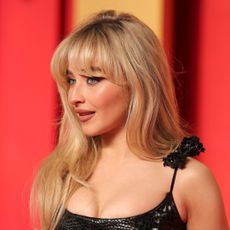 Sabrina Carpenter Wears Vintage Victoria's Secret Lingerie to Tease Upcoming Coachella Performance
Sabrina Carpenter Wears Vintage Victoria's Secret Lingerie to Tease Upcoming Coachella PerformanceHer look was pulled from the brand's 1997 archives.
By Lauren Tappan Published
-
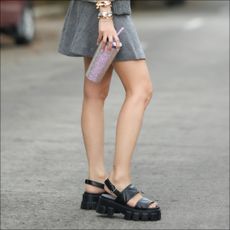 The Best Chunky Sandals Prove Minimalism Is Out
The Best Chunky Sandals Prove Minimalism Is OutAnother footwear trend embracing maximalism in 2024.
By Lauren Tappan Published
-
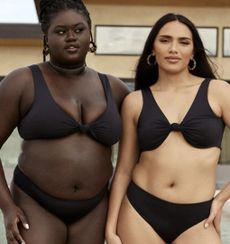 The Brands to Shop for the Best Swimsuits
The Brands to Shop for the Best SwimsuitsFrom size-inclusive labels to sustainable and designer options, this list is all-encompassing.
By Lauren Tappan Published
-
 The Best Vacation-Worthy Beach Dresses
The Best Vacation-Worthy Beach DressesFrom barely-there to playful fringe.
By Lauren Tappan Published
-
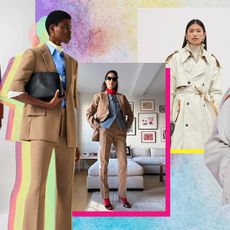 Could a 'Shirt Sandwich' Pull You Out of a Fashion Rut?
Could a 'Shirt Sandwich' Pull You Out of a Fashion Rut?The gourmet styling trick may help you fall back in love with your wardrobe.
By Emma Childs Published
-
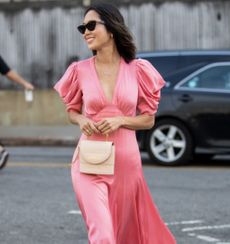 The Best Spring Dresses Simplify Any Outfit Formula
The Best Spring Dresses Simplify Any Outfit FormulaStyle this wardrobe staple for any occasion, from farmer's markets to formal affairs.
By Lauren Tappan Published
